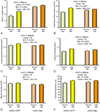Body mass influences cortical bone mass independent of leptin signaling
- PMID: 19095090
- PMCID: PMC3522417
- DOI: 10.1016/j.bone.2008.10.058
Body mass influences cortical bone mass independent of leptin signaling
Abstract
Obesity in humans is associated with increased bone mass. Leptin, a hormone produced by fat cells, functions as a sentinel of energy balance, and may mediate the putative positive effects of body mass on bone. We performed studies in male C57Bl/6 wild type (WT) and leptin-deficient ob/ob mice to determine whether body mass gain induced by high fat intake increases bone mass and, if so, whether this requires central leptin signaling. The relationship between body mass and bone mass and architecture was evaluated in 9-week-old and 24-week-old WT mice fed a regular mouse diet. Femora and lumbar vertebrae were analyzed by micro computed tomography. In subsequent studies, slowly and rapidly growing ob/ob mice were injected in the hypothalamus with a recombinant adeno-associated virus containing the leptin gene (rAAV-lep) or a control vector, rAAV-GFP (green fluorescent protein). The mice were maintained on a regular control diet for 5 or 7 weeks and then subdivided into groups and either continued on the control diet or fed a high fat diet (45% of kcal from fat) for 8 weeks. In the WT mice, femoral and vertebral bone mass was positively correlated with body mass (Pearson's r=0.65-0.88 depending on endpoint). rAAV-lep therapy dramatically decreased body mass (-61%) but increased femur length. However, in the distal femur and lumbar vertebra, rAAV-lep therapy reduced cancellous bone volume/tissue volume, trabecular number and trabecular thickness, and increased trabecular spacing. The high fat diet increased body mass, irrespective of vector treatment. Total femur bone volume, length, cross-sectional volume, and cortical volume and thickness were increased in mice with increased body mass, independent of rAAV treatment. In the distal femur, increased body mass had no effect on cancellous architecture and there were no vector x body mass interactions. In WT mice, increased body mass resulted in increased (+33%) vertebral cancellous bone volume/tissue volume. Increased body mass had minimal independent effect on cancellous vertebral bone mass in ob/ob mice. Taken together, these findings suggest that increased body mass has a positive effect on femur cortical bone mass that is independent of leptin signaling.
Figures





Similar articles
-
Central leptin gene therapy corrects skeletal abnormalities in leptin-deficient ob/ob mice.Peptides. 2007 May;28(5):1012-9. doi: 10.1016/j.peptides.2007.02.001. Epub 2007 Feb 12. Peptides. 2007. PMID: 17346852 Free PMC article.
-
Hypothalamic Leptin Gene Therapy Reduces Bone Marrow Adiposity in ob/ob Mice Fed Regular and High-Fat Diets.Front Endocrinol (Lausanne). 2016 Aug 16;7:110. doi: 10.3389/fendo.2016.00110. eCollection 2016. Front Endocrinol (Lausanne). 2016. PMID: 27579023 Free PMC article.
-
Hypothalamic leptin gene therapy prevents weight gain without long-term detrimental effects on bone in growing and skeletally mature female rats.J Bone Miner Res. 2011 Jul;26(7):1506-16. doi: 10.1002/jbmr.365. J Bone Miner Res. 2011. PMID: 21328617 Free PMC article.
-
Obesity and metabolic syndrome: long-term benefits of central leptin gene therapy.Drugs Today (Barc). 2002 Nov;38(11):745-57. doi: 10.1358/dot.2002.38.11.740201. Drugs Today (Barc). 2002. PMID: 12582458 Review.
-
Leptin and the sympathetic connection of fat to bone.Osteoporos Int. 2008 Jul;19(7):905-12. doi: 10.1007/s00198-007-0487-9. Epub 2007 Oct 9. Osteoporos Int. 2008. PMID: 17924050 Review.
Cited by
-
Leptin stimulates bone formation in ob/ob mice at doses having minimal impact on energy metabolism.J Endocrinol. 2017 Mar;232(3):461-474. doi: 10.1530/JOE-16-0484. Epub 2017 Jan 5. J Endocrinol. 2017. PMID: 28057869 Free PMC article.
-
Moderate weight gain does not influence bone metabolism in skeletally mature female rats.Bone. 2010 Sep;47(3):631-5. doi: 10.1016/j.bone.2010.06.010. Epub 2010 Jun 19. Bone. 2010. PMID: 20601291 Free PMC article.
-
Influence of High-Fat Diet on Bone Tissue: An Experimental Study in Growing Rats.J Nutr Health Aging. 2017;21(10):1337-1343. doi: 10.1007/s12603-017-0871-x. J Nutr Health Aging. 2017. PMID: 29188898
-
Leptin functions peripherally to regulate differentiation of mesenchymal progenitor cells.Stem Cells. 2010 Jun;28(6):1071-80. doi: 10.1002/stem.432. Stem Cells. 2010. PMID: 20506495 Free PMC article.
-
Peripheral leptin regulates bone formation.J Bone Miner Res. 2013 Jan;28(1):22-34. doi: 10.1002/jbmr.1734. J Bone Miner Res. 2013. PMID: 22887758 Free PMC article.
References
-
- Burge R, Dawson-Hughes B, Solomon DH, Wong JB, King A, Tosteson A. Incidence and economic burden of osteoporosis-related fractures in the United States, 2005–2025. J Bone Miner Res. 2007;22:465–475. - PubMed
-
- Asomaning K, Bertone-Johnson ER, Nasca PC, Hooven F, Pekow PS. The association between body mass index and osteoporosis in patients referred for a bone mineral density examination. J Womens Health (Larchmt) 2006;15:1028–1034. - PubMed
-
- Viapiana O, Gatti D, Dalle Grave R, Todesco T, Rossini M, Braga V, Idolazzi L, Fracassi E, Adami S. Marked increases in bone mineral density and biochemical markers of bone turnover in patients with anorexia nervosa gaining weight. Bone. 2007;40:1073–1077. - PubMed
-
- Felson DT, Zhang Y, Hannan MT, Anderson JJ. Effects of weight and body mass index on bone mineral density in men and women: the Framingham study. J Bone Miner Res. 1993;8:567–573. - PubMed
-
- Wang MC, Bachrach LK, Van Loan M, Hudes M, Flegal KM, Crawford PB. The relative contributions of lean tissue mass and fat mass to bone density in young women. Bone. 2005;37:474–481. - PubMed
Publication types
MeSH terms
Substances
Grants and funding
LinkOut - more resources
Full Text Sources
Medical
Molecular Biology Databases
Miscellaneous

